20.07.2025
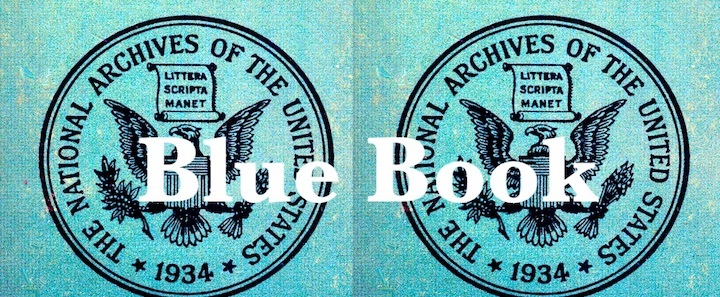
The 701 club Part 1: Case 2185 October 24, 1952 ElbertA, Alabama
Don Berliner describes the case as follows:
Oct. 24, 1952; Elberton, Alabama. 8:26 p.m. Witnesses: USAF Lt. Rau, Capt. Marcinko, flying a Beech T-ll trainer. One object, shaped like a plate, with a brilliant front and vague trail, flew with its concave surface forward for 5 seconds.1
Sparks’ entry is basically a duplicate of Berliner’s:
Oct. 24, 1952. Elberton [Elberta?], Alabama. 8:26 p.m. USAF Lt. Rau and Capt. Marcinko, flying a Beech T-11 trainer, saw an object, shaped like a plate, with a brilliant front and vague trail, fly with its concave surface forward. (Sparks; Berliner; Saunders/FUFOR Index).2
The Blue Book file
The Blue Book file contains a statement by Lt. Rau, a teletype message describing the incident, and an Investigative report. It also incorrectly identified the location as Elberton, Alabama. The actual location is Elberta. The important details are:
The plane was flying at 7500 feet, at a speed of 165mph and a heading of 075 degrees. The time of the sighting was 2026 CST on October 24, 1952.
The object appeared to the pilot’s left, about 10-15 degrees above the plane’s horizontal, and passed in front of the plane, disappearing to the right. It disappeared about 20 degrees above the plane’s horizontal.
It was larger than a star and had an orangish color to it. Duration was listed as 5 seconds.
A tail appeared to behind the object but it was thought to be an illusion by the pilot due to the object’s terrific speed.
The path was straight, with constant acceleration, and had an angle of attack of 5 degrees. Course was determined to be 200 degrees.
The weather was clear.
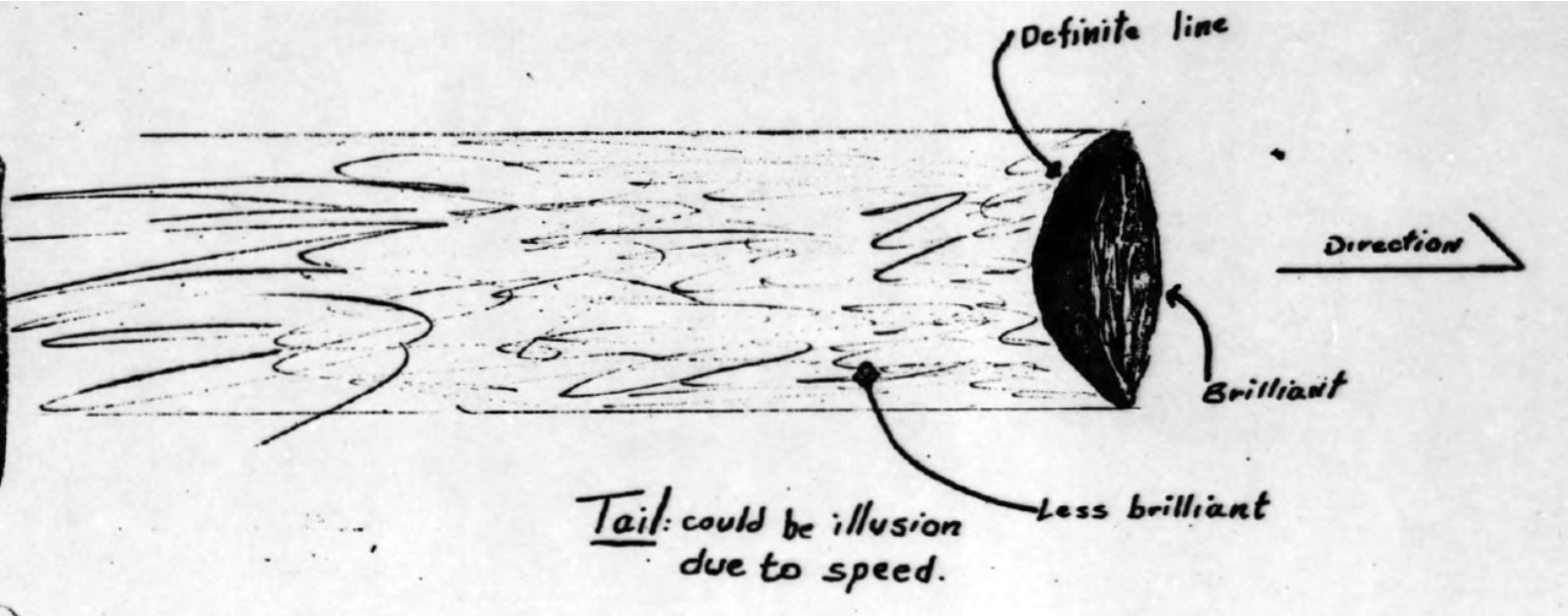
Analysis
There seems to be enough information in the file to examine the case. The object was seen at night, it traveled in a straight line, it was seen in the sky above the aircraft, and it was visible for a brief period of time measured in seconds. All of these are characteristics of a bright fireball meteor.
Conclusion
In my opinion, this case should never have been put on the list of unidentifieds The observations indicate this was probably a fireball meteor and it should be removed from the list of 701 Blue Book unknowns.
+++
The 701 club Part 2: Case 1827 and 1841 August 5-6, 1952 Haneda,Japan
Don Berliner describes the case as follows:
Aug 5. 1952; Haneda AFB, Japan. 11:30 p.m. Witnesses: USAF F-94 jet interceptor pilots lst Lt. W.R. Holder and lst Lt. A.M. Jones, and Haneda control tower operators. Airborne radar tracked a target for 90 seconds. Control tower operators watched 50-60 minutes while a dark shape with a light flew as fast as 330 kts. (380 m.p.h.), hovered, flew curves and performed a variety of maneuvers.1
Sparks’ entry is basically a duplicate of Berliner’s:
Aug 5-6. 1952. Haneda AFB, Japan (35°33’ N, 139°46’ E). 11:30 p.m. USAF F-94 jet interceptor pilots 1st Lt. W. R. Holder, 1st Lt. A. M. Jones, and Haneda control tower operators. Airborne radar tracked a target for 90 secs. Control tower operators watched 50-60 mins while a dark shape with a light flew as fast as 330 knots (380 mph), hover, fly curves and perform a variety of maneuvers, at one point splitting into 3 targets [?].(Sparks; Berliner; BB Status Report 8, Dec 1952, pp. 34-35).2
Both Sparks and Berliner state that case #1841, is a continuation of the Haneda sighting and is a duplicate. There is a document charge out form in the Blue Book files which has a handwritten note on it. It states, “Case missing Tokyo 8/6/52”.3 Either there was another sighting, or it is, as Sparks/Berliner determined, just a continuation of the Haneda sighting. It is my opinion, that they are correct and this case should be removed from the Blue Book unknowns as an entry that is either a duplicate or continuation of the sighting.
The Blue Book file4,5
The Blue Book file is pretty extensive. I found it in two different locations and there was a lot of information:
•The event started at 2330 local time on August 5
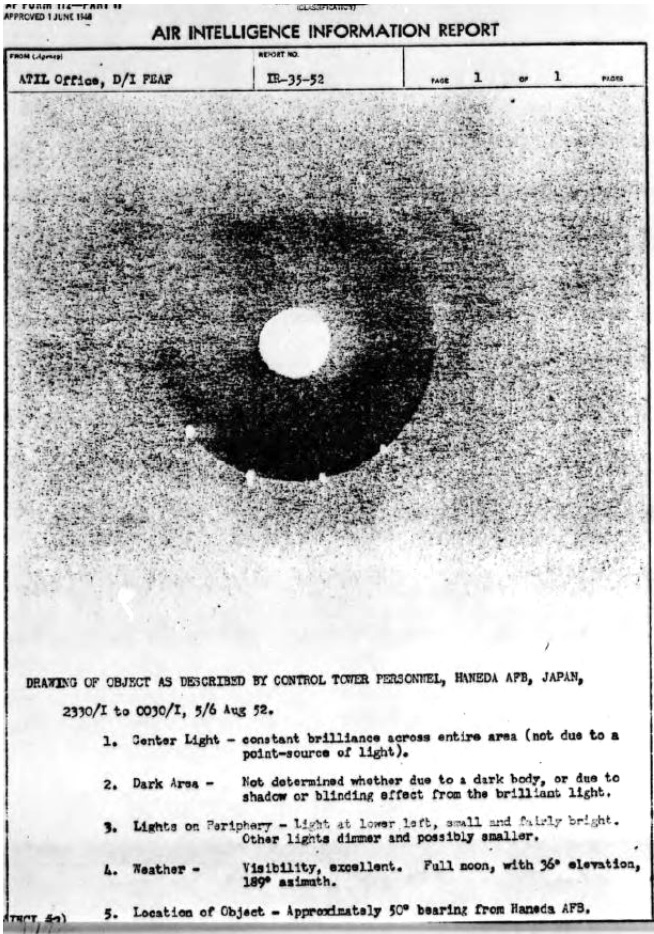
Two airmen coming on duty for the tower, saw an object as they were arriving.
They informed the others and they all observed the object for 50 minutes to an hour with 7X50 binoculars. The light was circular in shape but they perceived a dark shape behind the light. They noticed smaller, fainter lights around the lower edge of the dark object. It was described as being NE of Haneda tower at an approximate azimuth of 50 degrees (see image to the right at bottom).
The airmen thought it was an aircraft landing. It seemed to travel towards the East and gain altitude rapidly. It disappeared, and then, reappeared twice. It was visible until 0030, when it disappeared into broken cloud cover, which began to move into the area.
An airborne C-54 was asked to check on the light but the only thing they reported was seeing a star.
The AC&W unit was notified. They picked up an unidentified target at 2345 that was 8 miles to the NE of Haneda. The target was tracked with speeds varying from hovering to 300 knots.
At 2350, Tachikawa Air Base (24 miles to the WNW of Haneda) reported they could see a bright light over Tokyo Bay. This sighting line towards Tokyo Bay was towards the East and the ESE.
At 2355, an F-94 was scrambled to search to the NE of Haneda over Tokyo Bay.
The F-94 crew reported seeing the north star and Venus. The tower saw the aircraft headed north and they asked radar to direct the F-94 towards the east. (see flight path on next page left)
At 0012, the radar target broke up into three pieces 1/4 of a mile apart. Then the object disappeared. (see the radar contacts on the next page right)
At 0016 GCI directed the F-94 towards a target using a heading of 320 degrees. The radar operator picked up a contact at 6,000 yards. It moved from port to starboard rapidly and disappeared after 90 seconds. The operator could not obtain a lock-on. The pilot saw nothing visually. At this point the ground radar lost contact with the F-94 and target because they were lost in the ground clutter.
At 0033, the radar operators released the F-94 from their control. The F-94 continued to conduct an independent search until 0120. They saw nothing visually and only had the one radar contact.
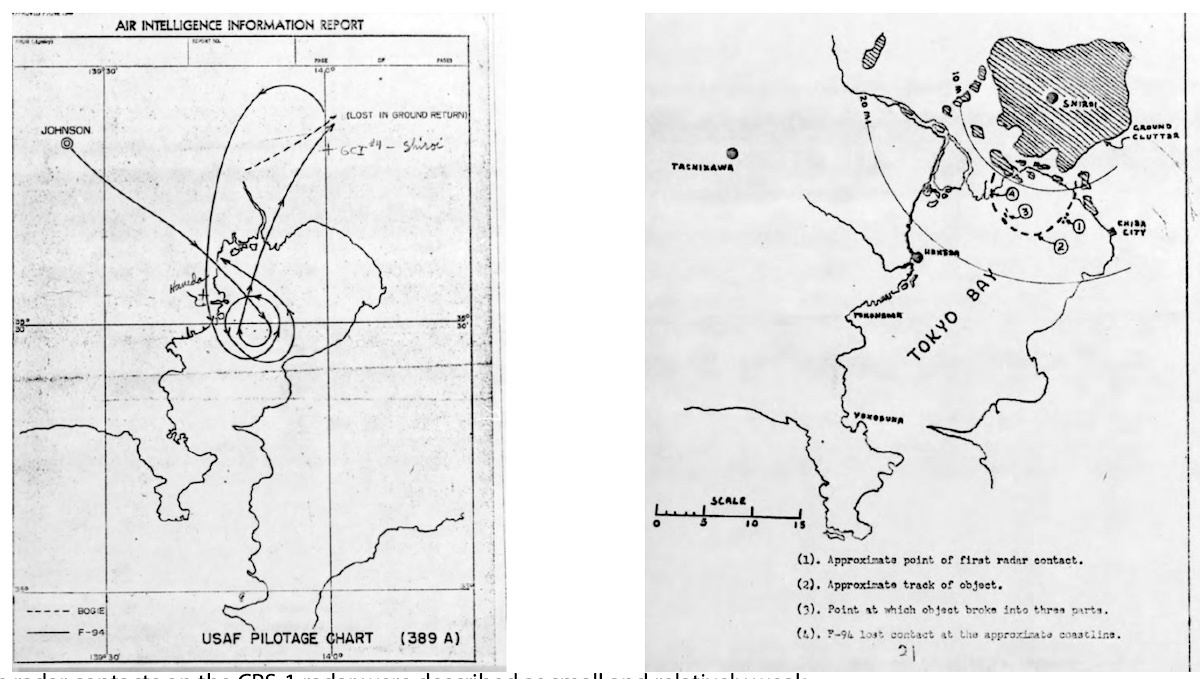
The radar contacts on the CPS-1 radar were described as small and relatively weak.
The weather had scattered low clouds with broken cloud cover at 16,000 feet. The broken cloud cover began to cover the moon at 0045 - 0100.
Analysis
A lot of analysis has been done on this case. Most notable were Dr. James McDonald’s “science in default” paper6 and Gordon Thayer’s evaluation in the Condon report.7 Not surprisingly, both disagree on how to interpret the information. Reading both, I find myself more accepting of the Thayer’s evaluation of the case than Dr. McDonald’s. One must remember that Dr. McDonald was on a mission to find UFO reports that he found compelling while the Condon study was trying to evaluate the cases to see if there was anything they could not reasonably explain. Some may argue that Condon was biased against UFOs, which means Thayer was either going to write an article that supported Condon’s bias or allow his own bias to interfere with analyze the cases. Remember, Thayer did consider the August 1956 Lakenheath case as a possible “mechanical device of unknown origin” so he did seem to be objective in his work.
The radar contacts appear to be false targets. The pilot, who was in the best position to see anything visually, saw nothing but stars/planets. Having to be directed towards the contact instead of seeing it visually, leads me to conclude the target was anomalous in nature. If we look at the plot of the radar contacts, we see they were all located at an azimuth ranging from about 50-75 degrees as observed from Haneda. This was the direction of the bright object the airmen saw but their object did not move towards the west and north, like this contact did. Instead, the visual moved eastward. Additionally, when the F-94 started going north to pursue the radar contact, the airmen felt it was going the wrong way and wanted the aircraft directed towards the east. All of this information indicates the radar contact was not related to the visual sighting.
If you read all the visual reports, they usually were using the direction of it being to the NE. There was only one witness statement in the file. This was Airman 3rd class West. He mentioned the object being to the NNE in his initial observation but the report implied the general opinion of the four airmen was that it was to the NE. In the sketch of the object, it gave an azimuth value of approximately 50 degrees for the sighting. Airman West also made the statement that the object was moving towards the East and increasing in altitude. He also noted it was clear to the east while they were observing it. This indicates, his initial observation was to what he though was NNE, when he was walking towards the tower, but, once he was stationary and got his bearings from the tower, he decided it was then towards the East or Northeast. If we look at the Tachikawa sighting of seeing a bright object towards the east or ESE, the bulk of the observations appear to have been east or northeast. The 50 degree azimuth is probably a reasonable
value with a +/- of 30 degrees because it was written as “approximately”.
There are two bright celestial objects in that direction. The first is Capella, which was at azimuth 34 degrees and 5 degrees elevation.
The second was Jupiter at azimuth 74 degrees and elevation 5 degrees. Both had risen around 2300. Capella, had some stars of 6-7th magnitude that were pretty close to it that would be visible in binoculars but Jupiter had brighter objects nearby. All four of the Galilean moons were near elongation making it possible to see all four moons with binoculars. Three were on the SW side of Jupiter and one was on the NE side. These could have been the fainter lights the witnesses mentioned. The dark object behind the light was probably something similar to the “airship” effect. The moons of Jupiter gave the illusion of some larger object behind the light. While the Condon report felt that Capella was the source, I am more inclined to accept Jupiter.

The F-94 pilot mentions seeing the north star and Venus that night. While Polaris (the north star) is always visible, Venus is not.
Venus, on August 5, 1952, was setting shortly after sunset. It was not really visible even in the evening sky. The pilot had probably confused Jupiter as Venus. Jupiter was pretty bright and it would be no surprise he made such an error. What is important to note is that he was looking and never saw anything but Jupiter. Remember the airmen stated the object was exceptionally bright. The chance of the pilot missing such an object is pretty small. Therefore, it seems likely that they were the same object.
The Shirori radar site also sent people outside looking for a UFO in the direction they recorded the target. They saw nothing. However, their radar contact was to the SSW and the only thing low in that direction was the moon. They would have not looked to the east.
Airman West remarked the object was not a star, a weather balloon or Venus because he compared the object to them. McDonald felt that meant he, like the pilot, confused Jupiter for Venus, but that is not what he stated. He did not state Venus was visible, he just stated he was comparing the object to Venus. Any object in the sky could have been Venus in his mind and not just Jupiter. Capella, Vega, Arcturus could have been what he thought was Venus or he was just remarking that he had seen Venus previously and this object was not it. Remember, he was looking at Jupiter, and its moons, with binoculars. Venus does not have moons and that means the object was different than what Venus looks like in binoculars. At no point, did West, or anybody else, ever state they saw the object in the same part of sky as Venus or any other bright celestial object. This, and the general direction of being in the northeast or east makes me conclude that it was probably Jupiter they were observing.
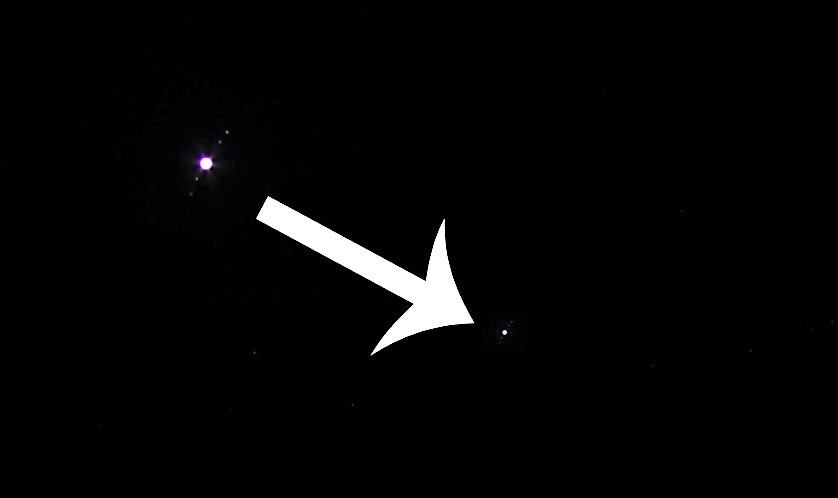
To the right is an image of Jupiter I took with a full frame camera and a 400mm lens. This is close to what one would expect to a pair of 7X binoculars. The actual view is to the bottom right. I zoomed in on the upper left to show the position of the moons more clearly. This is a photograph showing the scale but not the same as using hand-held binoc-
ulars. Trying to steady those binoculars is not easy and Jupiter, and its moons, would bounce around. This would allow imagination to take hold of seeing something dark behind the lights and the lights not being aligned properly with the planet.
Conclusion
In my opinion, that the case can be explained as possibly Jupiter and false radar targets. It should be removed from the list of 701 Blue Book unknowns. Additionally, Case 1841 can be considered a duplicate/continuation of the Haneda case. It also needs to be removed from the list of unknowns.
Quelle: SUNlite 2/2025
